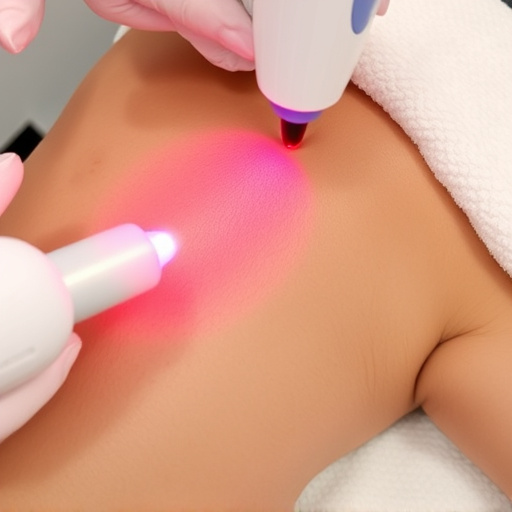Facial hair removal options include facial laser hair removal and electrolysis. Laser targets and destroys follicles with light energy, ideal for coarse hairs, offering permanent reduction in multiple sessions with minimal downtime. Electrolysis inserts needles into follicles to dissolve them with electrical current, suitable for all hair types, providing permanent results but taking more time per treatment. Both methods have benefits and cater to individual preferences and needs, with laser appealing for swift, pain-free results, and electrolysis ideal for precise targeting. Customized facials can complement these procedures for comprehensive skin care.
“Uncover the ultimate guide to achieving smooth, hair-free skin with our in-depth comparison of two popular facial hair removal methods: Laser Hair Removal and Electrolysis. Understand the science behind each technique and explore its pros and cons. Discover faster, shorter treatments with minimal downtime through lasers, but be aware of potential side effects and costs. Alternatively, electrolysis offers permanent results for coarser hairs but demands more time and frequent sessions. Find your perfect solution for a radiant, hair-free face.”
- Understanding Facial Hair Removal Methods
- – Overview of laser hair removal and electrolysis
- – How each method works on a physiological level
Understanding Facial Hair Removal Methods

Facial hair removal is a common concern for many individuals seeking smooth and radiant skin. When it comes to achieving this goal, two prominent methods stand out: facial laser hair removal and electrolysis. Understanding these techniques is essential in making an informed decision about which approach aligns best with your desired results.
Facial laser hair removal utilizes concentrated light energy to target and destroy hair follicles, preventing future hair growth. It offers a quick and effective solution, particularly for those with coarse or dark hair. This non-invasive procedure is often sought after for its ability to significantly reduce the appearance of unwanted facial hairs over multiple sessions. On the other hand, electrolysis involves inserting fine needles into the hair follicles and delivering electrical current to dissolve them, making it suitable for all hair types and skin tones. While it may require more time and patience compared to laser treatment, electrolysis provides a permanent solution, ensuring long-term freedom from facial hair. Both methods have their advantages and disadvantages, catering to different preferences and needs in the realm of facial treatments.
– Overview of laser hair removal and electrolysis

Facial laser hair removal and electrolysis are two popular methods for achieving smooth, hair-free skin. Laser hair removal uses concentrated light energy to target and destroy hair follicles, preventing future hair growth in the treated area. This non-invasive procedure is often sought after for its efficiency and long-lasting results, making it a preferred choice for many individuals seeking permanent solutions to unwanted facial hair. On the other hand, electrolysis involves inserting thin needles into the hair follicles and delivering an electrical current, which damages or destroys them, inhibiting hair regrowth. While electrolysis can be more time-consuming, it is considered safe and effective for all skin types.
Both techniques offer significant advantages when it comes to facial aesthetics. Laser treatments appeal to those looking for swift and relatively pain-free results, with minimal downtime. Moreover, combining laser hair removal with chemical peels or other aesthetic treatments can enhance overall skin health and texture. Electrolysis, though more prolonged, is praised for its precise targeting of individual follicles, making it suitable for sensitive areas like the face. Ultimately, the choice between these methods depends on personal preferences, budget, and desired outcome, as each has its own set of pros and cons tailored to specific needs.
– How each method works on a physiological level

Facial laser hair removal is a non-invasive procedure that utilizes focused light beams to target and destroy hair follicles. This technology emits intense pulses of light that penetrate the skin, selectively absorbing melanin in the hair shaft while minimizing damage to surrounding tissue. The heat generated disrupts the growth cycle of the hair, leading to reduced hair visibility over time. This method is particularly effective for coarse, dark hairs and offers a permanent hair reduction, although multiple treatments may be required for optimal results.
Electrolysis, on the other hand, involves inserting fine needles into the hair follicles, delivering an electrical current that damages or destroys them. The process stimulates the follicle to stop producing hair. Unlike laser removal, electrolysis is suitable for all hair colors and skin types, making it a versatile option. It provides permanent hair reduction but may be more time-consuming as each individual hair must be treated. Customized facials can enhance these procedures by addressing related skin health concerns, such as wrinkles reduction, ensuring a smoother transition towards achieving smooth, hair-free skin.
Facial laser hair removal and electrolysis offer distinct approaches to managing unwanted facial hair. Laser treatment provides long-lasting results with minimal side effects, while electrolysis ensures precise targeting of individual hair follicles. Both methods have their advantages and limitations. For permanent solutions, electrolysis might be the better choice due to its ability to destroy the hair root. However, laser removal is a faster and more convenient option, ideal for those seeking a sustained reduction in hair growth. The decision ultimately depends on individual preferences and the desired level of permanence.














